Like many people who have to use a computer all day, every day, as part of their job, I find that I regularly get a painful or numb feeling in my wrists and arms.
This is my story of what I’ve done to try to make that numbness and pain go away. I’ll add a usual disclaimer, pointing out that I’m not a medical expert, this is just personal account, and that you should get advice from a professional if you have any kind of pain.
Office work is dangerous
It all started when I began my first job in an office. People may think that working in an office is safe for your health. My experience is that it is not!
Over the first weeks and months that I was there I started getting a feeling of numbness in my wrists when I was sat at my desk using the keyboard and mouse. I also started getting knee pain, which is something I have previously written about.
DSE assessment
After this had been going on a while I decided to request a DSE (display screen equipment) assessment. Fortunately this easy to do at my company. Within a week I was visited by someone from a DSE company who looked at how I was sitting, and how I was using the keyboard, mouse, and monitor.
He made adjustments to a few aspects of the way I sat at my desk, including raising the height of my monitor, and making a few adjustments to my chair.
He raised my chair to make sure that I didn’t have to tilt my arms up to use the mouse and keyboard. Because of my raised chair, I had to get a foot rest as well to keep my legs comfortable.
He also gave basic advice such as telling me to take regular breaks from the computer.
To help me remember to take regular breaks I installed the free SCIROCCO Take a Break software which I configured to pop up a reminder every half an hour.
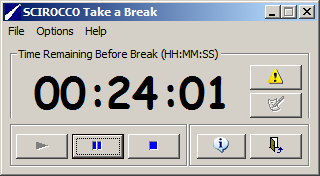
Learning to live with the numbness
I got the numb feeling in my wrists and arms every day I worked at the office, but I learnt to live with it. The severity of the problem wasn’t improving, but it wasn’t getting any worse either.
I’d found that the problem was always much worse if I worked with bare arms. If I had the sleeves of a jumper covering my arms the pain or numbness wouldn’t be as severe or as noticeable.
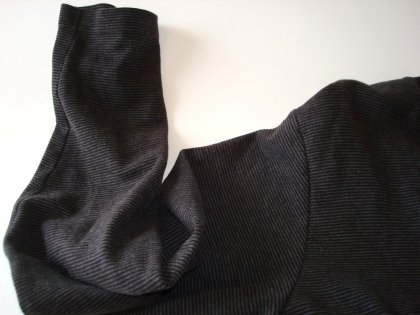
One theory I have for this is that when wearing a jumper, the extra fabric around my arms acts like a cushion, preventing me from constricting any of the nerves in my arm as severely as when they rest on my desk. This is just my personal theory, and I can’t give any scientific proof that it would work for anyone else.
You don’t always want to wear a jumper when it is hot so I discovered that I got the same improvement if I just wore fabric wristbands. You’ll find these in clothes shops that sell accessories.
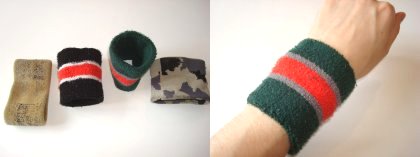
Wrist braces, pill popping, and exercisers
During this time I tried a number of other things to try to reduce the pain. I gave wrist braces a go, but I found them to be very restrictive for my wrist and arm movements. I much preferred using simple fabric wristbands as I spoke about above.
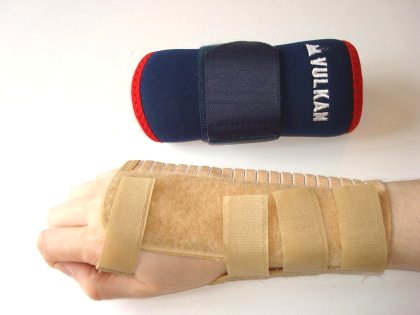
I tried using a number of different pills. I tried multi-vitamin tablets, cod liver oil, and glucosamine sulphate. It is possible that they helped with my general health, or even helped with my specific wrist problems, but to be honest I didn’t notice any difference when I was using them.

I also tried using wrist exercisers, but I didn’t find they improved anything. If anything I found that my wrists felt worse after using these.
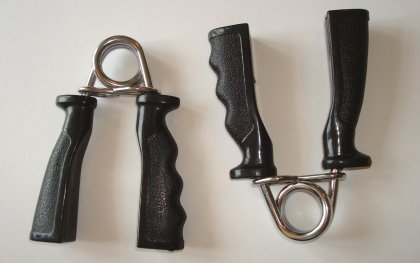
Electric conduction tests
After many years of putting up with my wrist problems I decided that I really should see my doctor. When I went to see him he asked me some questions, took a look at my arm, and then said he would refer me to the hospital to have some electrical conduction tests done on my right arm (the right was worse than the left). He said that I might have a mild form of carpel tunnel syndrome.
At the hospital they attached an electrode to one finger at a time, put some salt gel on my arm, and then measured how easily electricity conducted through the nerves. They also did tests that caused my fingers and arm to twitch as a result of the electricity.
I got the results a week later which said that my nerves were fine, and if anything was wrong with them it was very mild.
Physiotherapy for my wrist pain
I had private health insurance with Cigna from my employer, so I called them up to ask if I could see a physio about my wrist and arm pain.
They agreed, and authorised six physio sessions for me.
The physiotherapist started by asking about my problem, and then doing basic manipulations on my arms to judge what the problem was. She though the problem was caused by tightness in my muscles, not just around my arm and wrist, but also in my shoulders, neck, and back.
She explained how the nerves are connected, and how problems in your back can also affect your arm and wrist.
Over the weeks she did deep tissue massage on my arm to loosen up the tissue structures. This was quite painful, and would leave me with red and purple bruises.
She also did massage on my shoulder and back areas to loosen any tissue structures that might be constricting the nerves which lead to my hands.
As well as the deep tissue massage she showed me a variety of stretches. These weren’t just hand stretches, there were stretches for my back, arm and neck as well. She was trying to work on the whole length of where the problem might be coming from.
Another DSE visit
The physio wanted to see how I used my computer equipment. As my employer wouldn’t pay for an onsite visit (it wasn’t covered by the insurance), they arranged for the DSE assessor to visit again.
He once again looked at how my desk was set up. He made an additional recommendation. He said that I should change from using a full size keyboard to a mini-keyboard. He thought that the amount of travel my right arm had to do from the mouse to the keyboard might be causing problems.
The extra travel distance is caused by the numeric keypad of a full sized keyboard. I’ve highlighted in red the amount of travel when you use a full sized and mini keyboard in the photo below.
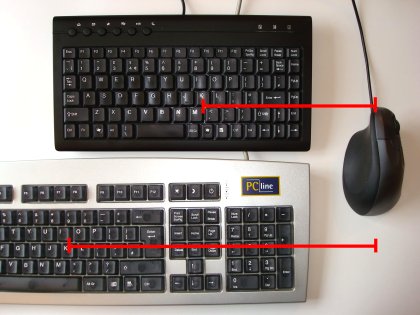
He took photos of me using my equipment which I was able to send to the physio.
Back at the physio
The physio was able to use the photos to make another suggestion. She thought that my mouse was causing me to twist my arm in an unnatural way. She recommended an ergonomic mouse.
She had a number of different ones which I was able to borrow, and after experimenting I settled on a vertical grip mouse like the one in the photo below. I bought it from Helashop (who don’t seem to exist anymore), but there are loads of other ergonomic mice available from Amazon as well. I’d advise you to try them before you buy, as they can feel quite strange at first.
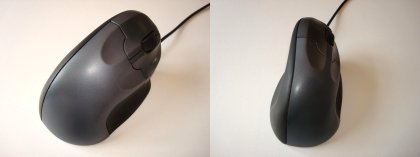
In the next photo you can see the difference one of these mice makes in the position and angle of my arm, as opposed to using a standard mouse.
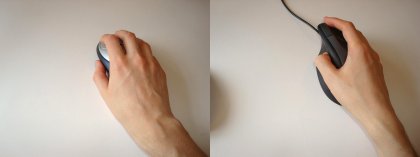
Two mice are better than one
I made a further change in my desk. I started using a second mouse. For the left hand I used a standard mouse, and I used the ergonomic mouse for my right hand. It does take a while to get used to using a mouse with your other arm, but you can do it if you practice for a few weeks.
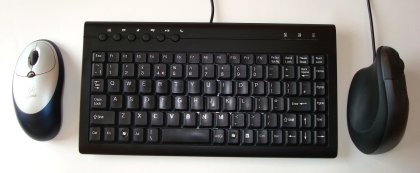
By using two mice rather than one you can spread the load more evenly over both arms, rather than having your dominant arm take most of the damage.
After 8 years, what worked, what didn’t
I’ve had knee and arm numbness for 8 years now, at varying degrees of severity. First of all these are the things that I found didn’t help me.
- Wrist braces – I found these too tight, and constricting for my work.
- Vitamins, Cod liver oil, Glucosamine – I didn’t notice any difference through using them.
- Wrist exercisers – No help to me. They seemed to make things worse.
Here is what helped me.
- DSE assessment – If you use a computer all day then make sure it is set up correctly. Any slight problems in the way you use them build up over time. Ask your employer if they can arrange for an assessment.
- Physio – Physio was very helpful, both to help me understand the causes of the problem, and to help with the treatment. It was definitely worth treating the back and shoulders as well as the specific wrist area.
- Stretching – I found the wrist, shoulder, neck, and back stretches reduced the severity of the problem. If you can’t motivate yourself to stretch regularly; a yoga, pilates, or dance class may help you.
- Wearing a jumper or wrist band – This isn’t a recommendation you often hear, but I find that keeping my wrist covered by fabric helped a lot.
- Ergonomic mouse – I did find my right arm was more comfortable when using the ergonomic mouse.
- Using two mice, left and right – Two is better than one as the load can be spread between the two arms.
- A mini keyboard – The reduced amount of travel of my arm between the mouse and mini keyboard help as well.
- Computer timer – I recommend you have a timer on your computer to remind you to take regular breaks. It is very easy to lose track of time, and end up spending hours using the computer without a break.

Unfortunately the Law is so vaguely drafted as regards screen breaks, any employer can drive a coach and horse through it. Basically the employer can claim that leaving the computer for 1 or 2 minutes per hour means staff are getting screen breaks. There is no definition as to the length of a break so 1 second can be a break or blinking and eye can be a break as there is no minimum length. My employer claims going to the printer occasionally fulfils the legal obligations. The DSE staff, pressurise the staff into giving the ‘right’ answers and fill in the form for them. The employer sets an impossible availability target of 85% for the day which includes tea breaks. They comply with the bare minimum of the law, free eye tests etc but exploit the weakness of the law to the max, cutting themselves a massive amount of slack.
Another problem is in the shape of computer desks. In order to cram as many desks in as possible and through sheer bad design, desks are frequently too narrow ie there is not enough depth in the desk, so the operator can rest their wrists on the table and sit at a comfortable distance from the screen.
Minimum sizes of fonts need to be regulated, as I often encounter software with microscopic font sizes.
Another problem is lack of fresh air in large open plan offices, with no access to windows. Staff are cooped up like battery hens. Lack of fresh air and exercise, hot humid environments etc lead to poor performance which managers counteract by micromanaging, high targets, pressure and constant monitoring.
This is all in the Civil Service which should be setting an example to other employers.
My best advice is to learn to use the mouse with both hands and switch over frequently – it only takes a few days.
Nevertheless I still developed tendonitis in both forearms / wrists and once the tendons are sensitised, it is very hard to get rid off.
what help me is the keyboard rest at the bottom of the keyboard and a chair with arm rests, makes all the difference.
Michael
You’re very lucky to have your health insurance sort you out!
I have also suffered since uni with back pain and a numbing arm with shooting pain. When I went to my GP she told me to stop sitting at my desk! Helpful… So I went to an osteopath privately. It was much better after seeing the osteopath a few times, and since becoming more aware of my posture and desk setup etc I have been better long term. There really needs to be more awareness about preventing these symptoms to start with! I feel now I’m just staving off later-life pain (I’m 25…). I was blissfully unaware as a student.
I’m surprised by a small keyboard tip, purely because I feel I hunch up more when I’m typing on a small keyboard. Good tips though. I agree on the wrist brace thing, I just felt like it was making my arm more numb.
It’s worth noting that the timer prompting a break is also useful for reducing impact on your vision!
Using a computer mouse during winter my right hand seemed to get freezing cold. Fixed it, cut several sheets of newspaper to the shape of the mouse pad, keyed them together with a couple of corner staples and now using it as a mouse mat hand never gets cold.
Years ago I got repetitive strain injury in my right arm from computer mouse usage. Saw many experts and specialists but non-fixed the problem. So I came up with a 10 second cure that fixed my RSI and now no matter how many hours I sit at the computer using the mouse no more RSI.
Here’s how:
Simply reverse the mouse so that the click buttons face you.
Grip the mouse on the left side at the bottom end facing you with your thumb.
Grip the mouse on the Right side at the bottom end facing you with your middle or second finger.
Now that the left mouse button, which in reverse becomes the right click button, falls conveniently under the first finger.
So to move the onscreen cursor, bend your fingers or straighten your fingers. This will move the cursors up or down.
To move the cursor left to right first bend your thumb and straighten your middle finger. Then to move it the other way simply straighten your thumb and bend your first finger.
You will find there is very little movement with the wrist, and practically none with the elbow and shoulder. So No RSI in that area.
Only one small problem all onscreen cursor movements are in reverse. So you have to give yourself time to get used to it. Once learned it is an asset for life.
After learning this method I came up with, I suddenly thought maybe the rest of the world had got it wrong. Or the original teachers wanted us to get RSI.
Getting an aching back whilst sitting at the computer ?
If you are getting an aching back from sitting long hours at the computer it may pay to check that the chair you are using has not reached its use by date (old and worn out). A new ergonomic computer chair will in many cases resolve the problem. If you know someone with a newer chair see if they will loan it to you for a few day’s. Within a week you may feel the benefits warranting you replacing your old computer chair with a new one.
One of the other problems in your computer room is you may be using a CFL (Compact flourescent lightbulb) The dim light from these bulbs causes eystrain, depression and if one is on a desk light within a few feet high levels of UV will cause skin cancer. If one breaks in a closed small room the mercury they contain can injure or kill. Simply change the bulb with a normal incandescent or a flourescent light.
For the last 30 years I have worked with all facets of computers. Since day one any computer that was brought to me was first taken outdoors, covers removed and then all dust blasted out with a reverse vacuum cleaner.
The reason being computer fans act like a vacuum not only keeping the computer cool but sucking in dust and also blowing out dust which you breath.
Several years ago I decided to set up a small computer company enabling me to work from home. After establishing my computer business I received 6 older ex government computers from another company requesting an upgrade of memory, sound and graphics cards.
As I have always been curious about dust in computers decided to send samples away to get tested and analysed. The result was the dust samples were loaded with asbestos dust. So I returned the computers untouched to the supplier with a warning letter. So one week after establishing my new company I phoned up the government office and cancelled my registration. Sort of health before income.
Removing dust from a computer can be a difficult task as there are a lot of hidden and unreachable areas such as under the motherboard and inside the power pack and CPU fan.
So what I do in my own case is have two duplicate computers. One I use and the other on standby, stored away. Once every six month the computer I have been using is taken outside, covers removed and then taking the garden hose blast the inside of the computer out with a water jet ‘Yes water’ not really good for electrical equipment but it is the mort efficient way to completely remove dust.
Then this spotlessly clean computer is placed in my steel home garage. Left for six months with the daily heat of the sun on the garage dries out the water and all moisture completely. So far for me this method has worked.
the top on my left hand was swallon and hurt now my whole arm is hurting I can not raise my arm to comb my hair. I work on a computer that is sitting on a banquet table all day, do you think this have something to do with it.
Hi Donna, if the pain gets worse when you use the computer that could be the cause. You really should see a doctor!
A banquet table doesn’t sound very ergonomic! If it is too high for the keyboard/mouse maybe you should try to position the keyboard/mouse at a lower level. I sit my keyboard/mouse on a plank of material which I put on my lap.
Hope it works out.
Heres how I came up with my own simple system for dealing with RSI (repetitive strain injury) from using a standard computer mouse over long periods.
Well after reading a document on the Internet of several pages put out by a University, and several other articles on the subject by many specialists and scientists on the Internet.
No positive cure, just things like. Cut back usage, try using your left arm, have several day’s rest when pain starts, Try other pointing devices, change the office seat to another one every half hour or so. The list went on and on. They have been working on it and poured millions of dollars into the problem worldwide with no apparent cure.
Anyway I sent a few emails out with a view to helping people with this worldwide problem….
Here is how I personally resolved the problem of RSI.
Having used the standard computer mouse for many years. Started to get RSI (repetitive strain injury) from long hours using it. My wrist, elbow and shoulder became stiff and sore. My right shoulder became so stiff and sore it literally creaked when I used my right arm. I tried my left hand. After a while same RSI problem.
One day sitting at my desk, thinking about it and the answer was so simple. I fixed the problem and cured the RSI in about 10 seconds. Now can use the standard computer mouse with my right hand, 7 days a week for as many hours as needed. No RSI.
It does not cost anything and you do not even have to replace the computer mouse with some fancy pointing device or gadget.
That’s great
How.
Simply reverse the mouse so that the click buttons face you.
Grip the mouse on the left side at the bottom end facing you with your thumb.
Grip the mouse on the Right side at the bottom end facing you with your middle or second finger.
Now that the left mouse button, which in reverse becomes the right click button, falls conveniently under the first finger.
So to move the onscreen cursor, bend your fingers or straighten your fingers. This will move the cursors up or down.
To move the cursor left to right first bend your thumb and straighten your middle finger. Then to move it the other way simply straightens your thumb and bends the middle finger.
You will find there are very little movement with the wrist, and practically none with the elbow and shoulder. So No RSI in that area.
Only one small problem all onscreen cursor movements are in reverse. So you have to give yourself time to get used to it. Once learned it is an asset for life.
After learning this method I came up with, suddenly thought maybe the rest of the world had got it wrong. Or the original teachers wanted us to get RSI.